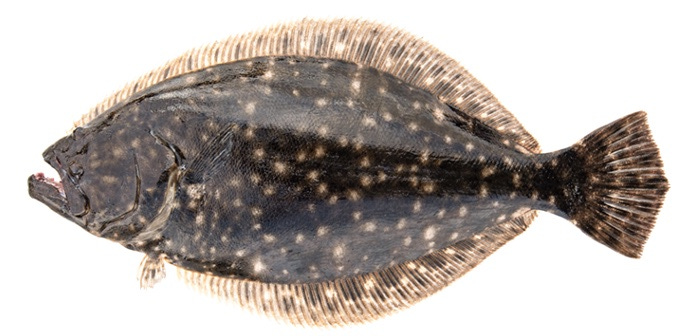“Flounder is the most popular fish on North Carolina menus,” says Willy Phillips, a commercial fisherman in Columbia, NC. “People love flounder because it’s not oily or fishy tasting, and fresh flounder is--lights out--more flavorful than frozen,” he adds.
For generations, catching a Southern flounder (Paralichthys lethostigma) has been a rite of passage for youngsters on the shores of North Carolina, creating lifelong appetites for the sweet, mild taste and the moist-but-flaky texture of this delicious fish. Nowadays, however, we are in danger of “loving flounder to death,” as Willy puts it.
As early as 2005, the NC Marine Fisheries Commission began sounding the alarm that Southern flounder—far and away the most populous of the three flounder species found in NC waters--was being overfished. Holly White, a conservation biologist, explains that unlike some of our neighboring states, North Carolina is mandated by state law to halt overfishing when it occurs and to implement measures to recover the diminished stock. Holly has been with the North Carolina Department of Environmental Quality (NCDEQ) for 15 years.
The NC Marine Fisheries Commission is leading the charge to rebuild the Southern flounder stock in North Carolina waters with seasonal constraints on commercial and recreational fishing. Catch and release of flounder by recreational fishermen is now discouraged because of the likely mortality of fish that are caught and then let go. In 2019, for the first time, the recreational fishing season for flounder was closed.
For commercial fishing operations, the open season has been shortened at times to avoid overages in the harvest. “We put fairly significant seasonal constraints on the commercial fishery in 2019 due to the sheer magnitude of the reduction needed to rebuild the stock,” says Anne Markwith, also a conservation biologist with NCDEQ. “Part of the reason that management is so stringent is the fact that a reduction to end overfishing is not enough to rebuild the stock.” Details on these regulations are available at the DEQ website.
Scientists and managers in South Carolina, Georgia, and Florida are now involved in the effort. Each state has its own regulatory systems. A coastal wide collaboration is therefore complex, both politically and scientifically. For its part, South Carolina increased the size limit on flounder while lowering the bag limit. Florida has also implemented additional regulations.
Commercial fisherman have complained, which is understandable given the upfront investment required for boats and equipment and the ongoing demand for flounder from the public. It’s harder to make a profit when the seasonal parameters are in flux. This spring, new population data will be released, and continuing restrictions on the state’s flounder harvest will be announced, all in an effort to continue to rebuild the stock to healthy levels.
At the same time, changing water temperatures in the Atlantic Ocean have also affected the flounder harvest in federal waters that are managed by Atlantic and Mid Atlantic government councils. Most of the fish caught in ocean waters are Summer flounder (Paralichthys dentatus), a different species. “Flounder out in the ocean are moving north, off the coast of New Jersey and New York.” Willy Phillips says. “Those flounder are chasing the spot and croaker that are also moving north toward cooler water.”
Maybe you have noticed that it seems to be getting harder to find flounder on menus and at fish markets around the state, a revelation that came to me a while back when the most reliable and excellent Squid’s Restaurant in Chapel Hill—now in its 38th year--did not always have flounder available.
At the Chapel Hill Farmer’s Market a couple of weeks ago, I checked in with Locals Seafood, a statewide distributor of fresh seafood from the NC coast. A fellow named Alan, who was working in the tent, said they had managed to obtain only 150 pounds of flounder that week, and they sold it all to their restaurant customers. Nothing was available for sale directly to the public.
“The flounder that is available this time of year is Summer flounder, not Southern, unless it was frozen during the season,” Anne Markwith explains. “The Summer flounder trawl fishery is currently open, where they fish off New York and New Jersey, not North Carolina.”
If price is any indication of scarcity, one exquisite entrée, “Parmesan-Onion Crusted Flounder,” is going for $35 on the menu at Niko’s, an upscale Greek restaurant in Durham. This delicate, baked preparation is served with roasted lemon potatoes, cucumber, shallot, and dill. Fortunately, the whole fish is a meal generous enough for two, by my reckoning. Niko’s told me they source their flounder from Wilmington through Simply Fresh, a seafood wholesale business headquartered in Durham.
New Bern, NC, on the west side of the Pamlico Sound, was the site last month for a gathering of flounder experts and other interested individuals at a symposium on the delicate fish. “It was a good meeting,” says Holly White. Researchers from East Carolina University and the University of North Carolina at Wilmington presented information about the ongoing collection of flounder population data and an initiative to better understand the habitat needs of Southern flounder. There has also been an increase in hands-on tagging of flounder in order to track the movement of the species by satellite across state and federal waters. Increasingly, volunteer citizen scientists are helping with this tagging effort, says White, a further indication of the flounder’s popularity.
In short, patience is required, and we should be proud that North Carolina has been a leader in the effort to rebuild the flounder stock. The state’s role in the management of flounder represents more than half of the harvest numbers for the coastal catch—from here down to southern Florida—so the state’s efforts are significant. Next time you find and order flounder, rejoice, and eat it slowly with a greater appreciation of your good fortune, and let’s support the conservation efforts of our environmental stewards.








I’m not hungry now Lol😳
That’s creepy 😝